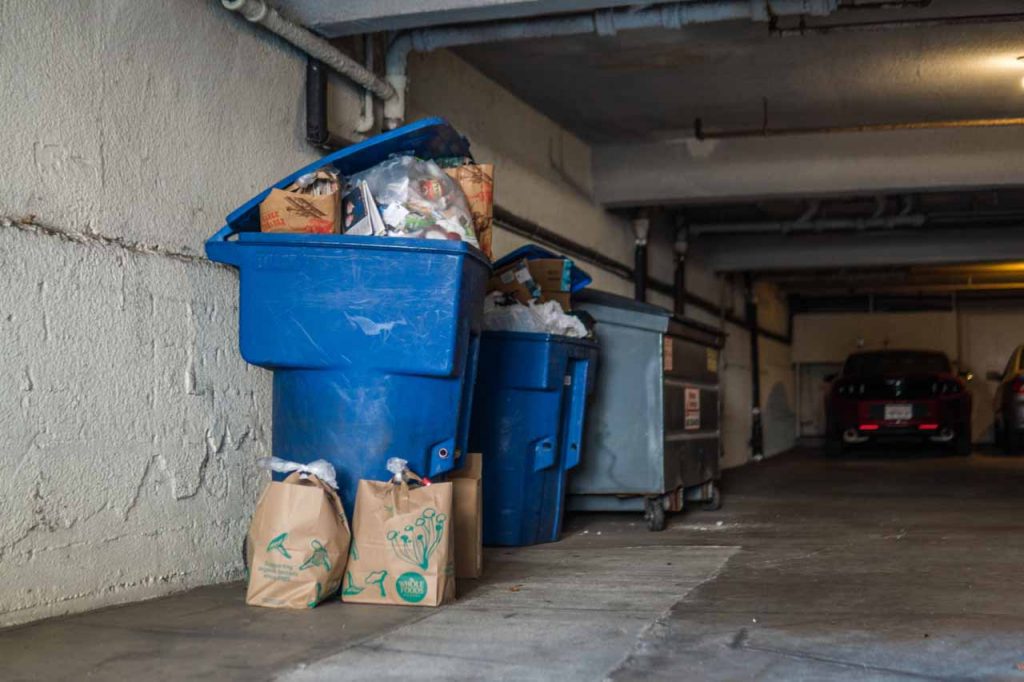
California cities of 50,000 residents or more are seeing inbound contamination rates between 8% and 46%, with an average of 20%. | Oksana Shturo/Shutterstock
Plastic film has long been identified as a major contaminant in municipal materials recovery programs. Research from the West Coast shows just how challenging it has been to educate residents around proper bag behavior.
According to a study released by The Recycling Partnership this week, a large chunk of residents in California, Oregon and Washington that participated in a recycling survey said they put plastic bags in their curbside collection carts. The majority of curbside programs, however, don’t list plastic film as an accepted material.
Across the region, more than 25% of respondents said they discard plastic film in curbside recycling. And the practice is even more pronounced in certain areas, according to The Recycling Partnership.
“Based on surveys focused in Southern California, we found that the majority of residents think plastic bags are accepted in their curbside recycling program, regardless of whether plastic bags are actually accepted by their program,” the report states.
The data comes from a wider West Coast-focused contamination research initiative undertaken by The Recycling Partnership, an organization that is backed by corporate stakeholders and is geared toward improving municipal recycling in the U.S.
The group undertook the project in 2019 to better understand material quality in communities of 50,000 people or more in California, Oregon and Washington.
The organization compiled available program data; surveyed local officials, haulers, processors and residents; and conducted interviews and focus groups. The findings were released May 4.
Given that the focus was contamination, it’s hardly surprising that plastic bags featured prominently in the findings. Film, though recyclable, is not accepted in most curbside collection efforts because the material wraps around machinery at materials recovery facilities (MRFs), causing significant downtime and increasing risks of worker injury.
As part of its research, The Recycling Partnership asked city officials and MRF operators to list what they considered the most problematic contaminants in the curbside stream. In each of the three states, both cities and MRFs put plastic bags near the top of their contaminant lists, alongside items such as needles and lithium-ion batteries.
But The Recycling Partnership also noted that its interaction with residents showed the issue can be effectively addressed.
“These well-intentioned participants said that just finding out that plastic bags cannot be placed in the recycling cart was motivation enough to change their behavior,” the group wrote in the report.
Overall recycling contamination around 20%
Looking at the contamination issue more broadly, the research found that 89% of residents in larger West Coast municipalities find it easy to participate in materials diversion and that, by and large, residents “want to recycle, recycle everything they can, and recycle the correct way.”
However, according to the report, California cities of 50,000 residents or more are seeing inbound contamination rates between 8% and 46%, with an average of 20%. In Oregon and Washington, cities reported contamination rates averaging 11%.
While those data points come from reporting and calculation mechanisms in place in different communities, which The Recycling Partnership notes are often lacking in consistency, the report does provide details on one particularly rigorous material audit in the Portland, Ore. region.
Field sampling of the curbside, single-stream recycling system in and around Portland determined the area had a 22% contamination rate.
That study, which also assessed recyclable material that ended up in the trash stream, showed the average household generated 594 pounds of recyclable material per year. Of that weight, 418 pounds per household went into curbside recycling, 132 pounds went into garbage and 44 pounds were collected through the state container deposit program.
The Recycling Partnership recommended more communities make efforts to dig deeper into their waste numbers.
“Cities and counties that can isolate curbside tonnage from other recycling streams and track contamination over time can see trends in their program’s efficiency,” the organization states in the contamination report. “This data can then be used to focus their education and outreach efforts, allowing the local program to make the education effort actionable and make the most out of the available resources.”
A version of this story appeared in Resource Recycling on May 5.


